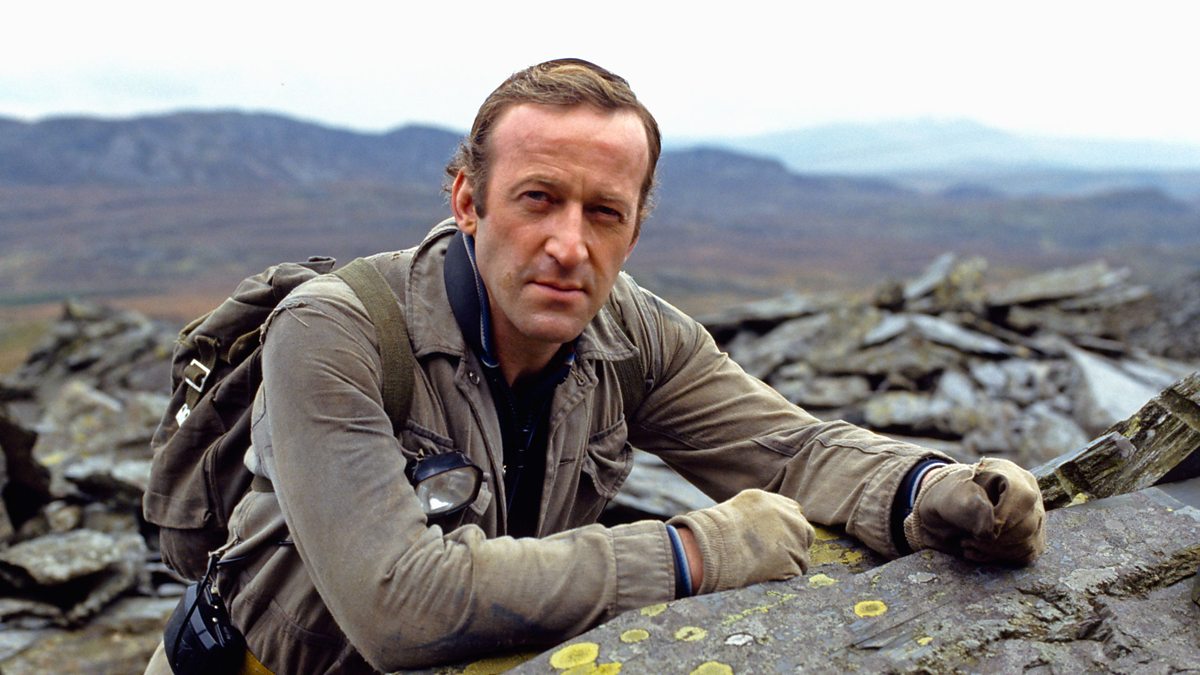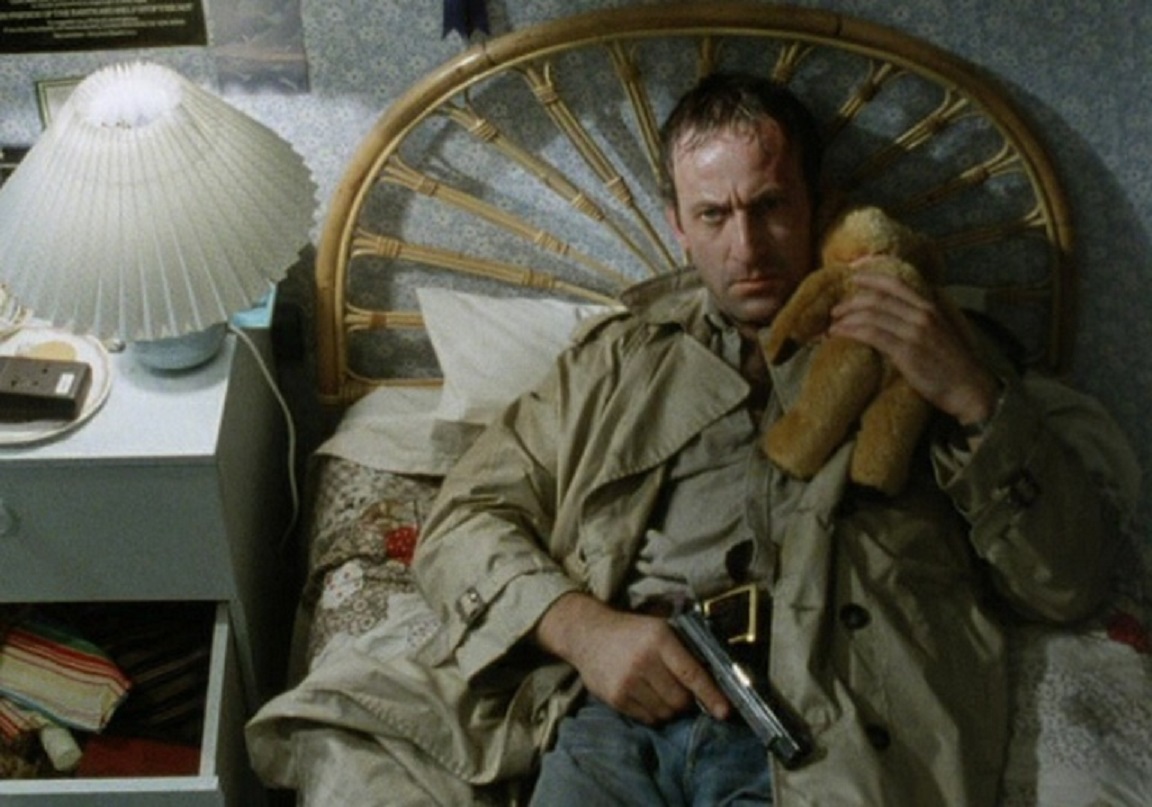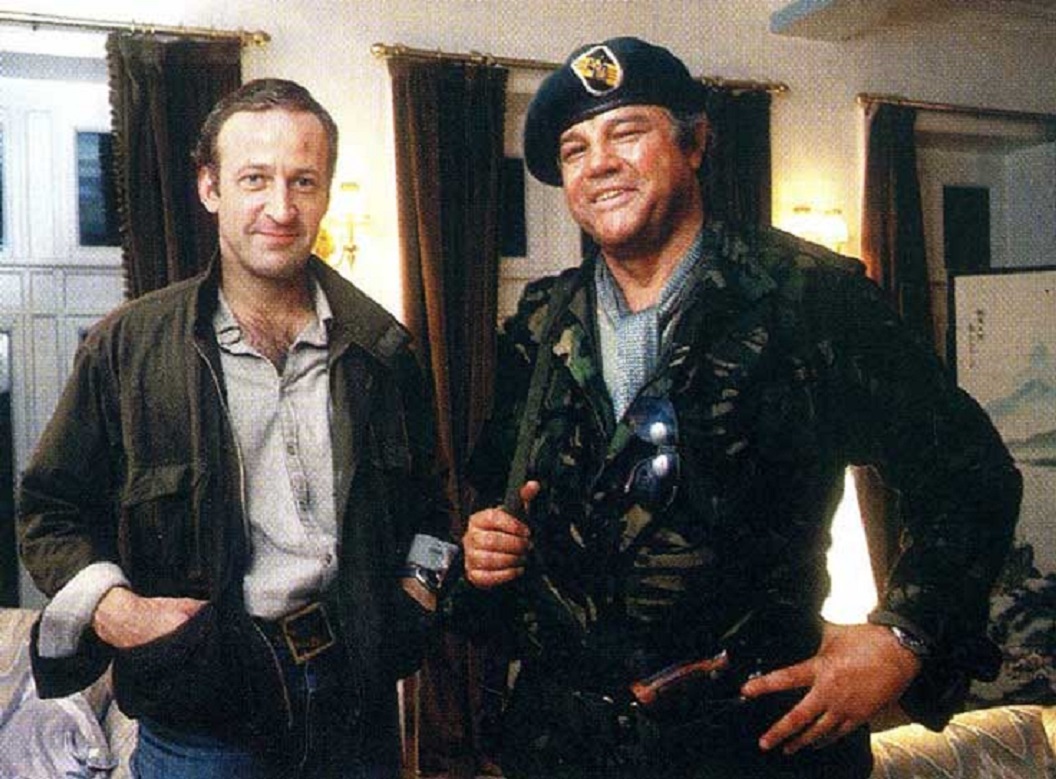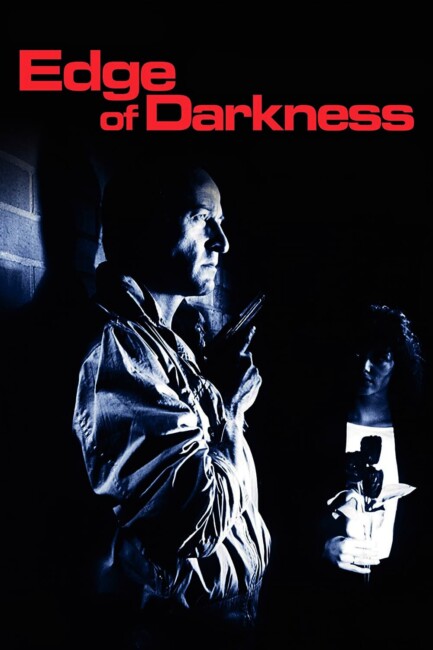UK. 1985.
Crew
Director – Martin Campbell, Teleplay – Troy Kennedy-Martin, Producer – Michael Wearing, Photography – Andrew Dunn, Music – Eric Clapton & Michael Kamen, Visual Effects Supervisor – Mat Irvine, Makeup Design – Daphne Croken, Design – Graeme Thomson. Production Company – BBC tv/Lionheart Television International.
Cast
Bob Peck (Inspector Ronald Craven), Joe Don Baker (Colonel Darius Jedburgh), Charles Kay (Guy Pendleton), Ian McNeice (Henry Harcourt), Joanne Whalley (Emma Craven), Hugh Fraser (Robert Bennett), Kenneth Nelson (Jerry Grogan), John Woodvine (Detective Chief Superintendant Ross), Jack Watson (James Godbolt), Tim McInnerny (Terry Shields), Zoe Wanamaker (Clemmy), Allan Cuthbertson (Chillwell), Imogen Staley (Young Emma), Sarah Martin (Polly Pelham)
Plot
One evening Yorkshire police inspector Ronald Craven is returning home with his 21-year-old daughter Emma when a man steps out with a shotgun. Emma is hit and killed as the man fires at them. In the aftermath, Craven’s police colleagues follow leads, believing it was a revenge killing by IRA paramilitaries from when Craven was stationed in Northern Ireland. However, as Craven examines Emma’s things, he uncovers disturbing truths about her involvement with the anti-nuclear group Gaia, including that her dead body is suffused with radiation. In London, Craven is contacted by shadowy men attached to the prime minister’s office who inform him that Emma was part of a group that broke into the nuclear power plant at Northmoor, seeking proof that the company was illicitly processing weapons grade plutonium. All the others with Emma’s group have been killed. As Craven becomes drawn into a labyrinthine conspiracy involving the government, the CIA and nuclear power industry, his police colleagues believe that his sanity is fraying and that explanations are more mundane. As a government enquiry is held over a bid by the powerful Fusion Corporation of Kansas to buy Northmoor, Craven and CIA agent Darius Jedburgh realize that the only way to bring the truth to light is to break into Northmoor themselves and return with the plutonium as evidence.
Edge of Darkness is one of the genuine landmarks of British television. It sits up there with a handful of other mini-series – Brideshead Revisited (1981), The Boys from the Blackstuff (1982), The Jewel in the Crown (1984), The Singing Detective (1986) – that were the absolute pinnacle of British televised art during the 1980s, something that seems to have fallen into decline since. Edge of Darkness was originally aired in six one-hour episodes but has been compiled in various different combinations since then. It won that year’s BAFTA for Best Drama Series/Serial and Best Actor for Bob Peck, along with four other wins and a further five nominations.
On the dvd extras, writer Troy Kennedy-Martin explains how Edge of Darkness he began writing the project in response to then conservative Prime Minister Margaret Thatcher’s policies. He wrote more as an attempt to voice his frustration than with any clear idea that the series would end up being made. As such, Edge of Darkness is a snapshot of the zeitgeist of the English nation in the early-to-mid-1980s. Troy Kennedy-Martin touches all the hot button issues of the day – the Thatcher government (there are even images from news broadcasts on tv of Mrs Thatcher defending the use of the nuclear deterrent), the government’s shadowy backroom deals with American corporations, Mrs Thatcher’s crushing of the miner’s strike in the mid-1980s, student political activism, the CND (Campaign for Nuclear Disarmament) and the high-profile women’s protest camp established outside the Greenham Common airfield where nuclear weapons were being stored, the prototypic environmentalist movement, Ronald Reagan’s Star Wars defence initiative, as well as Irish Republican terrorism in the background. That a mini-series can manage to cram so much political commentary in and still be compulsively watchable and not preachy didacticism is all to Troy Kennedy-Martin’s credit.
It is a script where Troy Kennedy-Martin has done his research on subjects like nuclear power (which proves refreshing in response to most treatments of nuclear power in science-fiction). Director Martin Campbell is enormously well attuned to Kennedy-Martin’s writing, allowing much of the series to take place in quiet understatement rather than opening it up into big dramatics. One of the wittiest scenes is where Joe Don Baker returns from assignment in South America and walks into the embassy quarters dressed in military combat khakis, upends a golf bag to dump the contents onto the floor, which consist of golf clubs, machine-guns and bottles of alcohol, before wandering into the next room to find a colleague crying and asks him “Did you tape the finale of Come Dancing?” – it is a scene that suggests all manner of character attributes and yet keeps subverting and playing them off one another without ever saying a single word of direct dialogue.

The story slowly and seductively absorbs one its dark mystery. Few other filmed works have done such a haunting job in portraying the shadowy corridors of power and the machinations that go on between high-level agencies. One of the finest aspects of the mini-series is Eric Clapton’s guitar score, which echoes with haunting effect throughout. Even the image that replays through several of the earlier episodes of trains of presumably nuclear waste creaking their way off into the night imbues the series with evocative effect – as though the trains are carrying the nuclear nightmare into a literal ‘edge of darkness’.
A thriller about the politics of nuclear power is not one that should necessarily concern us here as science-fiction, but where Edge of Darkness does broach genre material is during the last episode where Troy Kennedy-Martin expands the scope of the series out from being a political thriller onto a global scale to offer a grim vision of the future. The conference contains a stunningly written scene that contrasts Jerry Grogan’s promulgation of humanity’s future in space up against Jedburgh’s accusation that this will become less a universe of opportunity than a Wild West frontier governed by monopoly capitalism and run with a ruthless hand. (One of the uncanny things about Edge of Darkness in retrospect is how the character of nuclear power tycoon Jerry Grogan resembles an older version of Bill Gates – which in turn creates uncanny resonances between Grogan the plutonium entrepreneur who is tensed to run much of the world and Gates’s subsequent takeover of the domain of computing).
One of the most fascinating aspects of Edge of Darkness is when Troy Kennedy-Martin goes way off on a tangent regarding speculative environmental theories, introducing the idea that the Earth will protect itself from environmental damage with the creation of black flowers that draw heat from the sun and create warm patches that allow life to flourish, as apparently happened during the Ice Ages. Here, Troy Kennedy-Martin has taken the concept from a section in James Lovelock’s book Gaia: A New Look at Life on Earth (1977). The principal thesis of Lovelock’s book was that the Earth was a single living organism, which he called Gaia, and that it compensates in the same way that the health of a human body keeps itself in balance. This Gaia concept has taken off in New Age/Mother Goddess thinking during the 1990s, although scientists have criticised Lovelock’s denotation of purpose to non-intelligent organisms and lack of proof for such global self-regulation. Troy Kennedy-Martin would appear to advocate this mystical belief in the Earth as a quasi-sentient entity – a spring mysteriously appears where Joanne Whalley was shot, as though the entire Earth is in sympathy for her political activism. Kennedy-Martin’s thesis prefigures many themes that gained popularity in the environmental and anti-globalism movements of the 1990s and beyond. On one side, Kennedy-Martin contrasts a ruthless corporate power that even has governments at its beck and call, against a notion of the Earth itself fighting back against greed, exploitation and the environmental ruin this is causing. The haunting last image of the mini-series is of the black flowers growing in the Scottish Highlands.

One of the other fascinating fantastical aspects of the mini-series is the character of Joanne Whalley who is bumped off early in the first episode but continues to turn up throughout the rest of the series. Whether she is a ghost or a figment of Bob Peck’s decaying insanity is left carefully ambiguous. We presume the latter, but then she also imparts information that Peck could not possibly know – directions to find the map hidden in a book in the kitchen, providing information about the black flowers – that suggests she has some ontological existence.
One complaint might be made that the various plot machinations become so convoluted that it is difficult to work out who was behind everything. Despite the mini-series being set around Bob Peck’s quest for who was responsible for killing his daughter, it is never entirely clear at the end who authorised the killing. Furthermore, while the initial episodes give the impression that Bob Peck is startled to find that Joanne Whalley was involved with Gaia and that her body is suffused with radiation, the flashbacks confusingly give the impression that she tried to recruit him to lead the expedition down into Northmoor and therefore he must have known something.
The biggest piece of confusion is where the end revelations seem to improbably indicate that it was Jerry Grogan that called The President to give Jedburgh orders to break into Northmoor and bring back the plutonium in order to embarrass Grogan and scupper his own takeover deal. Apparently, Troy Kennedy-Martin wanted to end the mini-series with Bob Peck killed and transformed into a Green Man tree being protecting the Earth, but this was nixed for a more mundane ending, purportedly at the instigation of Bob Peck. It is a bizarre left field ending that would almost certainly have left audiences of the day scratching their heads.
Edge of Darkness brought to attention the great and quiet-spoken Bob Peck, whose virtue was always in portraying an ordinary man with complete sympathy. Peck went onto a promising career with roles in genre films like Slipstream (1989), Jurassic Park (1993) and another British mini-series Natural Lies (1992), which tried to conduct an Edge of Darkness with Mad Cow Disease conspiracies, before his death of cancer in 1999. Here, in the first episode in particular, Peck gives an exceptional performance as a man who seems to be carrying the weight of the world upon his shoulders. The sense of shock and bewilderment that plays out on his face as he sits on Joanne Whalley’s bed holding the gun he has found among her things in one hand a teddy bear in another is potent – it is a scene that needs to say nothing, all the confusion about what has happened to his sweet and innocent daughter is registered by the visual image. (For some reason, one image that always remains from when I first saw Edge of Darkness is of Bob Peck sitting on the bed kissing his daughter’s vibrator in his grief – an image that manages to be both incredibly tender and at the same time mildly indecent). Edge of Darkness also featured the lovely Joanne Whalley. Aged twenty-one, this was Whalley’s first high-profile role and she subsequently appeared in The Singing Detective and then found stardom in George Lucas’s Willow (1988) and Scandal (1989). There are equally good performances from Charles Kay and Ian McNeice as perfectly clipped and banally understated bureaucrats.

Of course, the one performance the lights up the entire mini-series is Joe Don Baker as Jedburgh. Before Edge of Darkness, Joe Don Baker was known for 1970s drive-in classics like Junior Bonner (1972), Charley Varrick (1973) and Walking Tall (1973), usually playing Southern law enforcement, and the odd genre item such as The Pack (1977) and Shadow of Chikara (1977), but Jedburgh is the finest role in Baker’s lengthy career. Baker plays to the gallery in a wonderfully gregarious caricature of a vulgar American but one that is also shot through with a piercing intelligence. The dialogue that Baker gets positively shines, be it he drunkenly singing Johnny Cash songs or the barnstorming scene where he takes over the conference and produces two pieces of fissile plutonium. The latter is a dramatic show capper where Troy Kennedy-Martin’s writing is utterly stunning. It is one of the great dramatic scenes of the 1980s.
The story was later remade as a feature film Edge of Darkness (2010) by the mini-series’ director Martin Campbell. The story was transferred to the US with the role of Craven played by Mel Gibson and with Ray Winstone inheriting Jedburgh. This could be politely termed as a travesty that abandons almost all of the nuclear power and environmental aspects and merely becomes a corporate whistleblower film with an angry Mel Gibson on a rampage determined to find the truth about his daughter’s murder.
Screenwriter Troy Kennedy-Martin also wrote films such as The Italian Job (1969), Kelly’s Heroes (1970) and the Arnold Schwarzenegger film Red Heat (1988), as well as episodes of British tv series like Z Cars (1962-78) and The Sweeney (1975-8), the mini-series Reilly, Ace of Spies (1983) and the nuclear war black comedy The Old Men at the Zoo (1983). Director Martin Campbell had previously gained a name on various British tv series and as director of several episodes of Reilly, Ace of Spies.
The success of Edge of Darkness launched Martin Campbell’s cinematic career with films that include the serial killer thriller Criminal Law (1988), the tv movie Cast a Deadly Spell (1991) about detective in an alternate world where magic works, the future prison film No Escape (1994), the James Bond films GoldenEye (1995) and Casino Royale (2006), the Zorro films The Mask of Zorro (1998) and The Legend of Zorro (2005), the cinematic remake of Edge of Darkness (2010), and the DC Comics superhero adaptation Green Lantern (2011).
Clip from the film here


